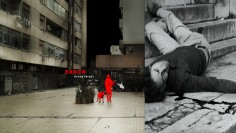VINCENT CICILIATO
Tempo Scaduto
source: vimeo
En partenariat avec les équipes de recherche MINT (Université Lille 1, CNRS, LIFL UMR 8022 & IRCICA, INRIA Lille Nord-Europe) et FOX (Université Lille 1, CNRS, LIFL UMR 8022) et INSID Inc. (Plaine Image). Coproduction : Honeymoon – Cinema e Restauro, Palerme, Italie. Désigner, viser, tirer : partant de ces trois injonctions communément utilisées dans le jeu vidéo, Tempo scaduto est une installation interactive qui place le spectateur dans la situation paradoxale de devoir prendre position tant physiquement qu’intellectuellement et moralement, face à une image et un récit qui vont le renvoyer à la conscience de son acte.
Sur fond de guerre des mafias à Palerme en Sicile dans les années 80, lieu et période de l’enfance de l’artiste, le récit se décline, dans des décors différents, en plusieurs scènes dont certaines sont le théâtre d’un assassinat. Le « joueur » est informé par l’écran des possibilités qu’il a de tirer sur des cibles mouvantes, inspirées de meurtres réels ayant eu lieu à l’époque en différents points de la ville, souvent documentés par des photographes de presse comme Letizia Battaglia qui travaillait pour le journal quotidien L’Ora ; ces images sont restées gravées dans la mémoire de Vincent Ciciliato.
.
.
.
.
.
.
.
source: vimeo
Ready, aim, fire: based on these three orders commonly used in video games, Tempo scaduto is an interactive installation which places the spectator in the paradoxical situation of having to take up position both physically as well as intellectually and morally, faced with an image and a story that will make him aware of his act. Against the backdrop of mafia war in Palermo in Sicily in the 80’s, place and time of the artist’s childhood, the story unfolds in different settings and several scenes, some of which are the stage of a murder. The «player» is informed on the screen of the possibilities he has to fire at moving targets inspired by real murders which took place at the time in different parts of the city, often documented by press articles like those of Letizia Battaglia who worked for the daily paper L’Ora; these images are engraved in the memory of Vincent Ciciliato.
.
.
.
.
.
.
.
source: we-make-money-not-art
he Tempo Scaduto game is set in the Palermo of the 1980s, when magistrates Giovanni Falcone and Paolo Borsellino began a campaign of arrests, trials and convictions of members of the Cosa Nostra.
The Mafia’s retaliation was brutal. Bombings, murders, attacks on touristic spots and other demonstrations of violence. Vincent Ciciliato grew up against that background and the game he has developed unfolds in six different locations in Palermo, some of which are the stage of a murder. Players have to re-enact the murders and fire at moving targets inspired by real murders but they don’t actually know if the person is an innocent passerby or the specific person who has to be eliminated. The identity of the victim is revealed only after they have been shot (to kill people, players have to do the well-known gesture of holding a handgun up and then aiming and firing with the finger.) The executor becomes the witness when the shot is followed by a series of archives documents that reveal the murder that took place at that exact spot some 30 years ago.
.
.
.
.
.
.
.
source: vimeo
Vincent CICILIATO is a multimedia artist, musician, composer and researcher Arts. As part of its visual and theoretical research, he focuses the relationship between sound and image in the interactive and generative devices, but also their involvement in aesthetic representative and screenplay. Much of his works examine the body while addressing the specific concepts of behavior and micro-movement.
.
.
.
.
.
.
.
source: vincentciciliato
Vincent Ciciliato est artiste multimédias, compositeur et docteur en arts plastiques. Ses préoccupations, autant esthétiques que théoriques, se situent à la lisière des arts visuels et des arts sonores. Bien plus qu’à la seule question de l’interdisciplinarité, il s’intéresse d’avantage aux apports fondamentaux des technologies numériques dans les modalités de fusion de ces deux domaines. Ainsi, il avancera la notion d’objet imago-sonore pour qualifier certains types d’objets numériques dans lesquels le son et l’image agissent en étroite corrélation. Cette problématique le pousse à interroger la notion de micro-événement – qu’il considère comme lieu privilégié des fusions audiovisuelles – et plus précisément celle de micro-mouvement. Il élargit ainsi son étude à l’image du corps en explorant certains lieux particuliers de la micro-gestualité et de ce que nous pourrions qualifier d’infra-mince postural : la banalité du geste, mais également son exacerbation obsessionnelle, seront des thématiques qu’il explore à plusieurs reprises dans ses œuvres plastiques.
La notion purement structurelle d’objet imago-sonore, appliquée à l’image corporelle, lui permettra donc d’avancer certains traits spécifiques au geste contemporain et à ses modalités dans ses œuvres plastiques.
La notion purement structurelle d’objet imago-sonore, appliquée à l’image corporelle, lui permettra donc d’avancer certains traits spécifiques au geste contemporain et à ses modalités de représentation. Un corps dans sa forme pathologique : entre gestes frénétiques – hyper-stimulés, hyper-éléctrifié – et état de stase insurmontable.


